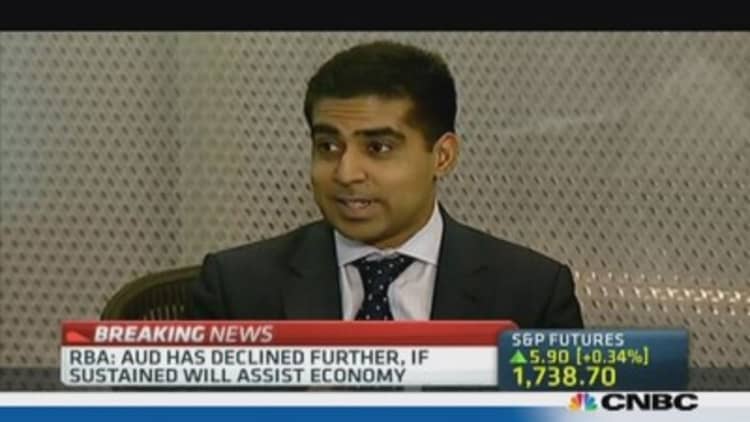
The Australian dollar was the clear outperformer in an otherwise dismal session in Asia on Tuesday, after the Reserve Bank of Australia (RBA) left interest rates on hold in its first policy meeting of the year.
The currency (AUD) surged 1.7 percent against the U.S. dollar to $0.8896, levels not seen in almost three weeks, and jumped 1.8 percent versus the yen.
The RBA kept its cash rate at a record low of 2.5 percent and said the current monetary policy was appropriate. While the decision was widely expected, analysts say the removal of the "easing bias" from its statement was the trigger for Aussie's huge rally.
(Read more: Has the tide turned for corporate Australia?)
"The RBA meeting was significant because it removed its lose easing bias and showed no concern around emerging markets or the AUD being uncomfortably higher," Chris Weston, Chief Market Strategist, at trading firm IG.
"The spike higher in the AUD against all G10 pairs was significant (with AUD/USD rallying over one cent) and anyone looking to sell the AUD in part of a central bank divergence trade has closed out rather quickly today," he added.
The change in the central bank's easing stance is significant for the Aussie dollar, as the RBA has, for the most part of 2013, publicly voiced its desire for a weaker currency in hopes of boosting the country's economic growth.
(Read more: 2014 a 'litmus test' for Australia economy: Goldman)
Analysts say the prospect of higher interest rates could also bode well for the currency, which lost 15 percent of its value against the greenback last year.
"[The] rate cut cycle is over, now it's a matter of when we take rates up, rather than if we take rates up," Phillips told CNBC.
"Their (RBA) note on inflation is about right, this gives me the sense that they are expecting a longer term of no rate change at all. But I still believe that the medium term, there'll be an increase. Remember, these are emergency level rates that we haven't seen in four decades. These are serious discounts in interest rates, we need to get back to normal rates in a matter of time," he added.
According to Shane Oliver, head of investment strategy and chief economist at AMP Capital, rates will remain low in the near term though signs are building that growth will pick up later in the year.
(Read more: Another reason why Australians are lucky)
"Our view remains that interest rates will be on hold out to around September/October when they will start moving up in response to a pick-up in growth," he said.
But Jonathan Cavenagh, senior currency strategist at Westpac Institutional Bank, says it's probably too early to assume it's upwards for the Aussie from here.
"We will need to talk about potential RBA rate hike and re-acceleration in China growth and both of that have low probability in this stage," he said.
"To get back into a net long position, the macro atmosphere around the currency has to improve further from here," he added.
- By CNBC's Li Anne Wong. Follow her on Twitter @LiAnneCNBC

